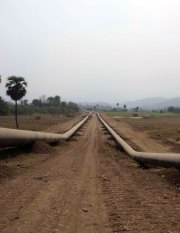“There is No Benefit, They Destroyed our Farmland”
By EarthRights International • April 8, 2013 See the photo essay: Selected Land and Livelihood Impacts Along the Shwe Natural Gas and China-Myanmar Oil Transport Pipeline from Rakhine State to Mandalay Division.
See the photo essay: Selected Land and Livelihood Impacts Along the Shwe Natural Gas and China-Myanmar Oil Transport Pipeline from Rakhine State to Mandalay Division.
The Shwe natural gas project and the Myanmar-China oil transport project, commonly referred to as the “Myanmar-China Pipelines” or “Shwe Pipelines” are two of Myanmar’s largest energy projects that include offshore platforms, offshore and onshore pipelines, and onshore terminals, deep sea ports and storage and processing facilities. The pipelines will transport Myanmar’s gas from blocks A-1 and A-3 in the Bay of Bengal and oil from the Middle East and Africa through Myanmar to China. The pipelines will traverse sensitive marine ecosystems, dense mountain ranges, arid plains, rivers, jungles, villages and towns populated by ethnic Myanmar people and several ethnic nationalities along the pipeline’s path from Rakhine State through Magway and Mandalay Divisions, and northeast through northern Shan State to Yunnan, China. Resources transported through these pipelines will benefit consumers and industry in Yunnan and other western provinces in China and will supply the Myanmar government with multi-billion dollar revenues; little gas and no oil will be directed for domestic consumption in Myanmar. The Chinese National Petroleum Corporation (CNPC), the operator of the pipelines, recently stated that the projects could begin operating in early June, 2013. With significant work remaining, particularly in areas in northern Shan State where attacks against ethnic armed groups by the Myanmar military continues and in several locations where the pipeline has yet to be laid, it is likely that operations will be delayed until later in 2013 or beyond.
Communities and individuals interviewed by EarthRights International (ERI) in the project areas are overwhelmingly opposed to the pipeline projects and ERI, other groups, and individuals monitoring the projects have identified multiple adverse human rights and environmental impacts of the pipelines. This update, drawn from interviews with affected villagers, multiple investigations inside Myanmar, communications with companies operating the oil and gas projects, and public documents, illustrates several examples of the negative impacts of the Myanmar-China pipeline projects in western and central Myanmar.
This periodic update is limited in scope to provide a snapshot of overall project development. However, other impacts have been documented along the pipeline route, including environmental harms, lack of local benefits, and human rights violations, including severe human impacts in northern Shan State. While EarthRights International has not conducted field investigations in northern Shan State, the pipelines are increasing tensions as construction reaches the Chinese border where there is renewed armed conflict between the Myanmar Army and several ethnic armed groups. Reports on these subjects are available through the internet links accompanying this report.
EarthRights International’s aim in releasing this update is to provide information to local communities and civil society in Myanmar while also alerting companies and stakeholders of local perceptions and impacts of ongoing construction. Prior to publication, EarthRights received responses from Daewoo International Corporation (Daewoo International) and South-East Asia Gas Pipeline, Co, Ltd. (SEAGP), controlled by the Chinese National Petroleum Corporation, regarding impacts reported by locally affected individuals. EarthRights has incorporated their official company responses into this publication.
Tags: EarthRights International, Human Rights Violations, Land Confiscation, Shwe Gas Project
This post is in: Business and Human Rights, Environmental and Economic Justice, Spotlight
Related PostsTwo New Briefers Expose Failings with Myanmar’s First Special Economic Zone
Analysis of the Affected Communities’ Rights and Remedies Under Myanmar Law and JICA’s Guidelines
Analysis of EIA for Phase I of Thilawa SEZ
Over 1,000 in Mandalay Protest Mining Activities
First U.S. Companies Release Reports on Investments in Myanmar









 All posts
All posts